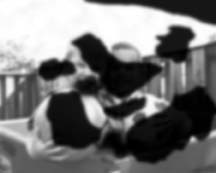Diabetic retinopathy (patient information): Difference between revisions
No edit summary |
No edit summary |
||
| Line 18: | Line 18: | ||
{{SI}} | {{SI}} | ||
{{CMG}}; '''Associate Editor(s)-In-Chief:''' Jinhui Wu, | {{CMG}}; '''Associate Editor(s)-In-Chief:''' Jinhui Wu, M.D. | ||
==Overview== | ==Overview== | ||
| Line 28: | Line 28: | ||
Image:Human eyesight two children and ball with diabetic retinopathy.jpg|The same view with diabetic retinopathy. | Image:Human eyesight two children and ball with diabetic retinopathy.jpg|The same view with diabetic retinopathy. | ||
</gallery> | </gallery> | ||
Early diabetic retinopathy does not have any symptoms. With the devolpment, people may notice one or more of the following symptoms: | Early diabetic retinopathy does not have any symptoms. With the devolpment, people may notice one or more of the following symptoms: | ||
*[[Bleeding]] | |||
*Blurred vision and gradual [[vision loss]], and even [[blindness]]. | |||
*[[Floaters]] | |||
*Shadows or missing areas of vision | |||
*Difficulty seeing at nighttime | |||
==Who is at highest risk?== | ==Who is at highest risk?== | ||
*All people with either Type 1 or Type 2 [[diabetes]] | |||
*The longer the patient has diabetes, the more likely he/she will get diabetic retinopathy. | |||
==How to know you have diabetic retinopathy?== | ==How to know you have diabetic retinopathy?== | ||
| Line 47: | Line 46: | ||
==When to seek urgent medical care?== | ==When to seek urgent medical care?== | ||
If you have [[diabetes]] and you have not seen an ophthalmologist in the past year, you need to schedule and appointment for a check up. | If you have [[diabetes]] and you have not seen an ophthalmologist in the past year, you need to schedule and appointment for a check up. Additionally, call your doctor if any of the following symptoms are new or are becoming worse: | ||
Additionally, call your doctor if any of the following symptoms are new or are becoming worse: | |||
*You cannot see well in dim light. | |||
*You have blind spots. | |||
*You have double vision | |||
*Your vision is blurry and you cannot focus. | |||
*You have pain in one of your eyes. | |||
*You are having [[headache|headaches]]. | |||
*You see spots floating in your eyes. | |||
*You cannot see things on the side of your field of vision. | |||
*You see shadows. | |||
Other health problems may also cause these symptoms. Only an ophthalmologist or physician can provide diagnosis. It is important to tell the doctor of these symptoms as soon as possible so that the problems can be treated as early as possible. | Other health problems may also cause these symptoms. Only an ophthalmologist or physician can provide diagnosis. It is important to tell the doctor of these symptoms as soon as possible so that the problems can be treated as early as possible. | ||
==Treatment options== | ==Treatment options== | ||
*Keeping a healthy lifestyle, including quitting smoking. | |||
*Treatment of diabetes: Tight control of [[blood sugar]], [[blood pressure]], and [[cholesterol]]. | |||
*Drugs: Now doctors inject corticosteroids into the eyeball to prevent abnormal blood vessels from growing. | |||
*Laser eye surgery: Laser surgery includes focal and scatter laser treatment. Focal laser [[photocoagulation]] is used to treat [[macular edema]]. And scatter laser treatment treats a large area of your retina. Before the procedure, the doctor dilates your pupil and applies drops to numb the eye. Then the doctor uses [[laser]] to keep vessels from leaking, or to get rid of abnormal, fragile vessels. After surgery, you will need to wear a pair of sunglasses and someone will have to drive you home. | |||
*Vitrectomy: Vitrectomy is used to treat [[bleeding]] in the center of the eye and to repair retinal detachment. This procedure is done under [[anesthesia]]. The doctor makes a tiny incision in your eye and replaces the vitreous gel that is clouded with blood with a salt solution. After the surgery, you may have to wear an eye patch for a few days or weeks to protect your eye. Additionally, [[eyedrop|eyedrops]] are needed to prevent infection. | |||
==Diseases with similar symptoms== | ==Diseases with similar symptoms== | ||
*Primary detachment of retina | |||
==Where to find medical care for diabetic retinopathy?== | ==Where to find medical care for diabetic retinopathy?== | ||
| Line 82: | Line 78: | ||
*Having regular check yearly under your ophthalmologist's direction | *Having regular check yearly under your ophthalmologist's direction | ||
*The following people are particularly advised to have a complete eye exam: | *The following people are particularly advised to have a complete eye exam: | ||
*Children older than 10 years who have had [[diabetes]] for 3 or more years | |||
*Adults and adolescents with type 2 diabetes soon after diagnosis | |||
*Adolescents and adults with type 1 diabetes within 5 years of diagnosis | |||
*If you are beginning a new exercise program or are planning to get pregnant | |||
==What to expect (Outook/Prognosis)?== | ==What to expect (Outook/Prognosis)?== | ||
Prognosis of diabetic retinopathy depends on: | Prognosis of diabetic retinopathy depends on: | ||
*Whether your [[blood sugar]] and [[blood pressure]] are controlled well. | |||
*Whether your retinopathy is treated early | |||
==Additional Links== | ==Additional Links== | ||
http://nihseniorhealth.gov/diabeticretinopathy/toc.html | http://nihseniorhealth.gov/diabeticretinopathy/toc.html | ||
http://www.nlm.nih.gov/medlineplus/ency/article/001212.htm | http://www.nlm.nih.gov/medlineplus/ency/article/001212.htm | ||
http://www.nei.nih.gov/health/diabetic/retinopathy.asp | http://www.nei.nih.gov/health/diabetic/retinopathy.asp | ||
[[Category:Opthalmology]] | [[Category:Opthalmology]] | ||
[[Category:Opthalmology patient information]] | [[Category:Opthalmology patient information]] | ||
| Line 106: | Line 98: | ||
[[Category:Disease state]] | [[Category:Disease state]] | ||
[[Category:Mature chapter]] | [[Category:Mature chapter]] | ||
[[Category:Patient Information]] | |||
[[Category:Medicine]] | |||
[[Category:Pediatrics]] | |||
[[Category:Endocrinology]] | |||
[[Category:Nephrology]] | |||
[[Category:Diabetes]] | |||
[[Category:Endocrinology patient information]] | |||
{{WH}} | {{WH}} | ||
{{WS}} | {{WS}} | ||
Revision as of 00:33, 29 July 2011
For the WikiDoc page for this topic, click here
| Diabetic retinopathy | |
| ICD-10 | H36 (E10.3 E11.3 E12.3 E13.3 E14.3) |
|---|---|
| ICD-9 | 250.5 |
| DiseasesDB | 29372 |
| MedlinePlus | 000494 Template:MedlinePlus2 |
Editor-In-Chief: C. Michael Gibson, M.S., M.D. [1]; Associate Editor(s)-In-Chief: Jinhui Wu, M.D.
Overview
Diabetic retinopathy is a complication of long-term diabetes and a leading cause of blindness. It is caused by changes in the blood vessels of the retina. In early stages, patients with diabetic retinopathy may not notice changes in vision. However, over time, diabetic retinopathy can get worse and cause floaters, shadows or missing areas of vision, difficulty seeing at nighttime, and even vision loss or blindness. Diabetic retinopathy can affects both eyes. A dilated eye exam and fluorescein angiography test are necessary for disgnosis. Treatments include quitting smoking; tight control of blood sugar, blood pressure, and cholesterol; laser eye surgery; and vitrectomy. For patients with diabetes, having regular eye exams under an ophthalmologist's direction is very important.
What are the symptons of diabetic retinopathy?
-
Normal vision. Courtesy NIH National Eye Institute
-
The same view with diabetic retinopathy.
Early diabetic retinopathy does not have any symptoms. With the devolpment, people may notice one or more of the following symptoms:
- Bleeding
- Blurred vision and gradual vision loss, and even blindness.
- Floaters
- Shadows or missing areas of vision
- Difficulty seeing at nighttime
Who is at highest risk?
- All people with either Type 1 or Type 2 diabetes
- The longer the patient has diabetes, the more likely he/she will get diabetic retinopathy.
How to know you have diabetic retinopathy?
- Visual acuity test: This eye chart test measures how well you see at various distances.
- Dilated eye exam: Drops are placed in your eyes to widen, or dilate, the pupils. Your eye care professional uses a special magnifying lens to examine your retina and optic nerve for signs of damage and other eye problems. After the exam, your close-up vision may remain blurred for several hours.
- Retinal photography or fluorescein angiography test: During this test, the doctor injects a special dye into the patient's arm and collects pictures as the dye passes through the blood vessels in the retina. The test can identify any leaking blood vessels.
When to seek urgent medical care?
If you have diabetes and you have not seen an ophthalmologist in the past year, you need to schedule and appointment for a check up. Additionally, call your doctor if any of the following symptoms are new or are becoming worse:
- You cannot see well in dim light.
- You have blind spots.
- You have double vision
- Your vision is blurry and you cannot focus.
- You have pain in one of your eyes.
- You are having headaches.
- You see spots floating in your eyes.
- You cannot see things on the side of your field of vision.
- You see shadows.
Other health problems may also cause these symptoms. Only an ophthalmologist or physician can provide diagnosis. It is important to tell the doctor of these symptoms as soon as possible so that the problems can be treated as early as possible.
Treatment options
- Keeping a healthy lifestyle, including quitting smoking.
- Treatment of diabetes: Tight control of blood sugar, blood pressure, and cholesterol.
- Drugs: Now doctors inject corticosteroids into the eyeball to prevent abnormal blood vessels from growing.
- Laser eye surgery: Laser surgery includes focal and scatter laser treatment. Focal laser photocoagulation is used to treat macular edema. And scatter laser treatment treats a large area of your retina. Before the procedure, the doctor dilates your pupil and applies drops to numb the eye. Then the doctor uses laser to keep vessels from leaking, or to get rid of abnormal, fragile vessels. After surgery, you will need to wear a pair of sunglasses and someone will have to drive you home.
- Vitrectomy: Vitrectomy is used to treat bleeding in the center of the eye and to repair retinal detachment. This procedure is done under anesthesia. The doctor makes a tiny incision in your eye and replaces the vitreous gel that is clouded with blood with a salt solution. After the surgery, you may have to wear an eye patch for a few days or weeks to protect your eye. Additionally, eyedrops are needed to prevent infection.
Diseases with similar symptoms
- Primary detachment of retina
Where to find medical care for diabetic retinopathy?
Directions to Hospitals Treating diabetic retinopathy
Prevention of diabetic retinopathy
- Tight control of blood sugar, blood pressure, and cholesterol
- Quitting smoking
- Avoiding resistance or high-impact exercises
- Having regular check yearly under your ophthalmologist's direction
- The following people are particularly advised to have a complete eye exam:
- Children older than 10 years who have had diabetes for 3 or more years
- Adults and adolescents with type 2 diabetes soon after diagnosis
- Adolescents and adults with type 1 diabetes within 5 years of diagnosis
- If you are beginning a new exercise program or are planning to get pregnant
What to expect (Outook/Prognosis)?
Prognosis of diabetic retinopathy depends on:
- Whether your blood sugar and blood pressure are controlled well.
- Whether your retinopathy is treated early
Additional Links
http://nihseniorhealth.gov/diabeticretinopathy/toc.html http://www.nlm.nih.gov/medlineplus/ency/article/001212.htm http://www.nei.nih.gov/health/diabetic/retinopathy.asp

